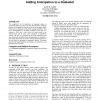217 search results - page 39 / 44 » Computational complexity of dynamical systems: The case of c... |
ATAL
2010
Springer
13 years 7 months ago
2010
Springer
Multi-agent learning is a crucial method to control or find solutions for systems, in which more than one entity needs to be adaptive. In today's interconnected world, such s...
CAISE
2006
Springer
13 years 10 months ago
2006
Springer
Abstract. We discuss a case study for the hospital scenario where workflow model components are distributed across various computers or devices (e.g. mobile phones, PDAs, sensors, ...
ACII
2011
Springer
12 years 6 months ago
2011
Springer
Communication between humans is rich in complexity and is not limited to verbal signals; emotions are conveyed with gesture, pose and facial expression. Facial Emotion Recognition ...
BMCBI
2008
13 years 6 months ago
2008
Background: Structural analysis of biochemical networks is a growing field in bioinformatics and systems biology. The availability of an increasing amount of biological data from ...
AGENTS
2001
Springer
13 years 11 months ago
2001
Springer
The complexity of AI characters in computer games is continually improving; however they still fall short of human players. In this paper we describe an AI bot for the game Quake ...

